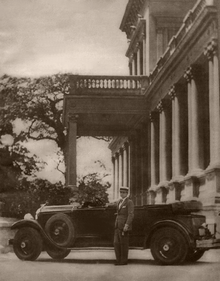Chôros No. 4
| Chôros No. 4 | |
|---|---|
| by Heitor Villa-Lobos | |
.jpg) Heitor Villa-Lobos | |
| Catalogue | W218 |
| Genre | Chôros |
| Form | Chôros |
| Composed | 1926: Rio de Janeiro |
| Dedication | Carlos Guinle |
| Published | 1928: Paris |
| Publisher | Max Eschig |
| Recorded | 30 November 1949 Alfred Braim, Sinclair Lott, Richard Parissi (horns), Harold Diner (trombone) (LP, 12 in., monaural, Capitol P 8147, Hollywood: Capitol Records, issued 1954) |
| Duration | 5.5 mins. |
| Movements | 1 |
| Scoring | Three horns and trombone |
| Premiere | |
| Date | 24 October 1927 |
| Location | Salle Gaveau, Paris |
| Performers | Edmond Entraigue, Jean-Lazare Pénable, and Mr. Marquette, horns; Jules Dervaux, trombone |
Chôros No. 4 is a quartet for three horns and trombone, written in 1926 by the Brazilian composer Heitor Villa-Lobos. It forms a part of a series of fourteen numbered compositions collectively titled Chôros, ranging from solos for guitar and for piano up to works scored for soloist or chorus with orchestra or multiple orchestras, and in duration up to over an hour. Chôros No. 4 is one of the shorter members of the series, a performance lasting about five-and-a-half minutes.
History

Chôros No. 4 was composed in Rio de Janeiro in 1926, and was premiered on 24 October 1927 at the Salle Gaveau in Paris, in the first of a pair of concerts devoted to works by Villa-Lobos. The performers were Edmond Entraigue, Jean-Lazare Pénable, and Mr. Marquette, horns; Jules Dervaux, trombone. On the same programme, Arthur Rubinstein gave the premiere of Rudepoêma. The first North American performance took place on 16 October 1940 at the Museum of Modern Art in New York City. The score is dedicated to Villa-Lobos's patron Carlos Guinle, the brother of the dedicatee of Chôros No. 5 (Villa-Lobos, sua obra 2009, 22).
Analysis
When an American University professor wrote to Villa-Lobos requesting an analysis of Chôros No. 4, the composer responded: "My works are meant to be played, not analysed" (Nóbrega 1975, 49).
The work is in three parts, subdivided into nine sections. The first part comprises subsections 1–6, the second part is an undivided, slow "cradle song" (subsection seven), and the last part consists of subsections 8 and 9. The third, concluding part is contrasted to everything that precedes it, and is closer to jazz or Cuban music than to anything Brazilian (Tarasti 1995, 103–105).
According to another opinion, the work actually falls into two sections, forming an AB form structurally analogous to Chôros No. 10, in which the second part is distinguished by the character of popular music (Salles 2009, 233)
References
- Appleby, David P. 2002. Heitor Villa-Lobos: A Life (1887–1959). Lanham, MD, and London: Scarecrow Press. ISBN 0-8108-4149-5.
- Albuquerque, Joel Miranda Bravo de. 2012. "Choros No 4 e No 7 de Villa-Lobos: dois procedimentos diferentes envolvendo o uso de eixo de simetria como fator estrutural". Anais do II Simpósio Villa-Lobos: Perspectivas Analíticas para a Música deVilla-Lobos, São Paulo, 23 a 25 de novembro de 2012, edited by Paulo de Tarso Salles and Ísis Biazioli de Oliveira, 275–88. São Paulo: Departamento de Música/Escola de Comunicações e Artes/Universidade de São Paulo. ISBN 9788572050982.
- Nóbrega, Adhemar Alves da. 1975. Os chôros de Villa-Lobos. Rio de Janeiro: Museu Villa-Lobos.
- Salles, Paulo de Tarso. 2009. Villa-Lobos: processos composicionais. Campinas, SP: Editora da Unicamp. ISBN 978-85-268-0853-9.
- Tarasti, Eero. 1995. Heitor Villa-Lobos: The Life and Works, 1887–1959, translated from the Finnish by the author. Jefferson, NC, and London: McFarland & Company, Inc., Publishers. ISBN 0-7864-0013-7.
- Villa-Lobos, Heitor. 1972. "Choros: Estudo técnico, estético e psicológico", edited in 1950 by Adhemar Nóbrega. In Villa-Lobos, sua obra, second edition, 198–210. Rio de Janeiro: MEC/DAC/Museu Villa-Lobos.
- Villa-Lobos, sua obra. 2009. Version 1.0. MinC / IBRAM, and the Museu Villa-Lobos. Based on the third edition, 1989.
Further reading
- Béhague, Gerard. 1994. Villa-Lobos: The Search for Brazil's Musical Soul. Austin: Institute of Latin American Studies, University of Texas at Austin, 1994. ISBN 0-292-70823-8.
- Branda Lacerda, Marcos. 2011. "Aspectos harmônicos do Choros n. 4 de Villa-Lobos e a linguagem modernista". Revista Brasileira de Música 24, no. 2 (July–December): 276–96.
- Mathie, David. 1991. "An Important Alternative in Horn Chamber Music: Heitor Villa-Lobos' Choros No. 4". The Horn Call 21, no. 2 (April): 35.
- Negwer, Manuel. 2008. Villa-Lobos: Der Aufbruch der brasilianischen Musik. Mainz: Schott Music. ISBN 3-7957-0168-6. Portuguese version as Villa Lobos e o florescimento da música brasileira. São Paulo: Martins Fontes, 2009. ISBN 978-85-61635-40-4.
- Peppercorn, Lisa M. 1980. "A Villa-Lobos Autograph Letter at the Bibliothèque Nationale (Paris)". Latin American Music Review / Revista de Música Latinoamericana 1, no. 2 (Autumn–Winter): 253–64.
- Peppercorn, Lisa M. 1991. Villa-Lobos: The Music: An Analysis of His Style, translated by Stefan de Haan. London: Kahn & Averill; White Plains, NY: Pro/Am Music Resources Inc. ISBN 1-871082-15-3 (Kahn & Averill); ISBN 0-912483-36-9.
- Wright, Simon. 1992. Villa-Lobos. Oxford Studies of Composers. Oxford and New York: Oxford University Press. ISBN 0-19-315476-5 (cloth); ISBN 0-19-315475-7 (pbk).
External links
- villalobos.iu.edu Villa-Lobos site at Indiana University: Maintained by the Latin American Music Center